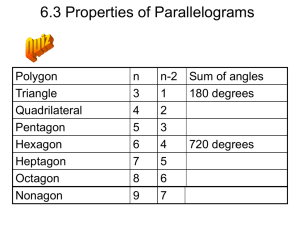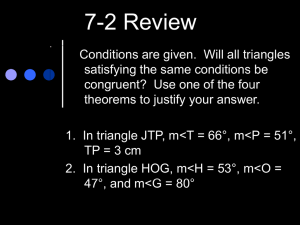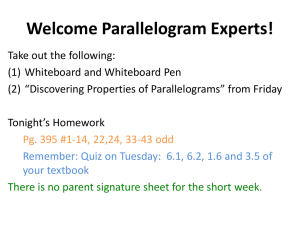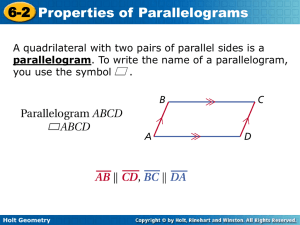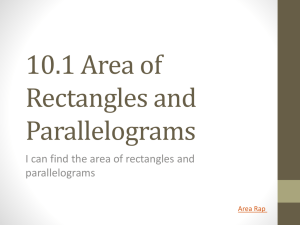g_ch06_03 Conditions for Parallelograms
advertisement
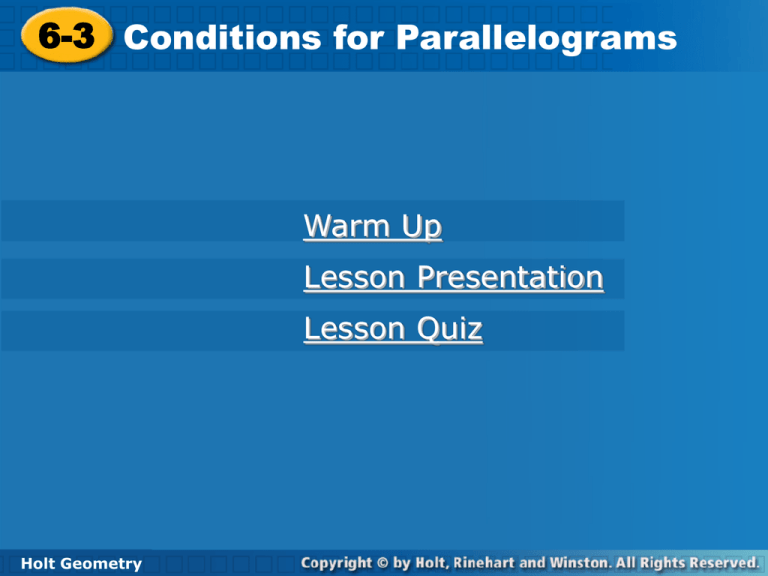
6-3 6-3 Conditions Conditionsfor forParallelograms Parallelograms Warm Up Lesson Presentation Lesson Quiz Holt Geometry Holt Geometry 6-3 Conditions for Parallelograms Lesson Quiz 1. Name the polygon by the number of its sides. Then tell whether the polygon is regular or irregular, concave or convex. nonagon; irregular; concave 2. Find the sum of the interior angle measures of a convex 11-gon. 1620° 3. Find the measure of each interior angle of a regular 18-gon. 160° 4. Find the measure of each exterior angle of a regular 15-gon. 24° Holt Geometry 6-3 Conditions for Parallelograms Lesson Quiz: Part I In PNWL, NW = 12, PM = 9, and mWLP = 144°. Find each measure. 1. PW 18 Holt Geometry 2. mPNW 144° 6-3 Conditions for Parallelograms Lesson Quiz: Part II QRST is a parallelogram. Find each measure. 2. TQ 28 Holt Geometry 3. mT 71° 6-3 Conditions for Parallelograms Lesson Quiz: Part III 5. Three vertices of ABCD are A (2, –6), B (–1, 2), and C(5, 3). Find the coordinates of vertex D. (8, –5) Holt Geometry 6-3 Conditions for Parallelograms Lesson Quiz: Part IV 6. Write a two-column proof. Given: RSTU is a parallelogram. Prove: ∆RSU ∆TUS Statements 1. RSTU is a parallelogram. Reasons 1. Given 2. cons. s 3. R T 3. 4. ∆RSU ∆TUS 4. SAS Holt Geometry opp. s 6-3 Conditions for Parallelograms Warm Up Justify each statement. 1. 2. Reflex Prop. of Conv. of Alt. Int. s Thm. Evaluate each expression for x = 12 and y = 8.5. 3. 2x + 7 31 4. 16x – 9 183 5. (8y + 5)° 73° Holt Geometry 6-3 Conditions for Parallelograms Objective Prove that a given quadrilateral is a parallelogram. Holt Geometry 6-3 Conditions for Parallelograms You have learned to identify the properties of a parallelogram. Now you will be given the properties of a quadrilateral and will have to tell if the quadrilateral is a parallelogram. To do this, you can use the definition of a parallelogram or the conditions below. Holt Geometry 6-3 Conditions for Parallelograms Holt Geometry 6-3 Conditions for Parallelograms The two theorems below can also be used to show that a given quadrilateral is a parallelogram. Holt Geometry 6-3 Conditions for Parallelograms Example 1A: Verifying Figures are Parallelograms Show that JKLM is a parallelogram for a = 3 and b = 9. Step 1 Find JK and LM. JK = 15a – 11 Given LM = 10a + 4 Substitute JK = 15(3) – 11 = 34 and simplify. LM = 10(3)+ 4 = 34 Holt Geometry 6-3 Conditions for Parallelograms Example 1A Continued Step 2 Find KL and JM. KL = 5b + 6 KL = 5(9) + 6 = 51 Given JM = 8b – 21 Substitute and simplify. JM = 8(9) – 21 = 51 Since JK = LM and KL = JM, JKLM is a parallelogram by Theorem 6-3-2. Holt Geometry 6-3 Conditions for Parallelograms Example 1B: Verifying Figures are Parallelograms Show that PQRS is a parallelogram for x = 10 and y = 6.5. mQ = (6y + 7)° mQ = [(6(6.5) + 7)]° = 46° Given Substitute 6.5 for y and simplify. mS = (8y – 6)° Given Substitute 6.5 for y and simplify. mR = (15x – 16)° Given Substitute 10 for x mR = [(15(10) – 16)]° = 134° and simplify. mS = [(8(6.5) – 6)]° = 46° Holt Geometry 6-3 Conditions for Parallelograms Example 1B Continued Since 46° + 134° = 180°, R is supplementary to both Q and S. PQRS is a parallelogram by Theorem 6-3-4. Holt Geometry 6-3 Conditions for Parallelograms Check It Out! Example 1 Show that PQRS is a parallelogram for a = 2.4 and b = 9. PQ = RS = 16.8, so mQ = 74°, and mR = 106°, so Q and R are supplementary. Therefore, So one pair of opposite sides of PQRS are || and . By Theorem 6-3-1, PQRS is a parallelogram. Holt Geometry 6-3 Conditions for Parallelograms Example 2A: Applying Conditions for Parallelograms Determine if the quadrilateral must be a parallelogram. Justify your answer. Yes. The 73° angle is supplementary to both its corresponding angles. By Theorem 6-3-4, the quadrilateral is a parallelogram. Holt Geometry 6-3 Conditions for Parallelograms Example 2B: Applying Conditions for Parallelograms Determine if the quadrilateral must be a parallelogram. Justify your answer. No. One pair of opposite angles are congruent. The other pair is not. The conditions for a parallelogram are not met. Holt Geometry 6-3 Conditions for Parallelograms Check It Out! Example 2a Determine if the quadrilateral must be a parallelogram. Justify your answer. Yes The diagonal of the quadrilateral forms 2 triangles. Two angles of one triangle are congruent to two angles of the other triangle, so the third pair of angles are congruent by the Third Angles Theorem. So both pairs of opposite angles of the quadrilateral are congruent . By Theorem 6-3-3, the quadrilateral is a parallelogram. Holt Geometry 6-3 Conditions for Parallelograms Check It Out! Example 2b Determine if each quadrilateral must be a parallelogram. Justify your answer. No. Two pairs of consective sides are congruent. None of the sets of conditions for a parallelogram are met. Holt Geometry 6-3 Conditions for Parallelograms Helpful Hint To say that a quadrilateral is a parallelogram by definition, you must show that both pairs of opposite sides are parallel. Holt Geometry 6-3 Conditions for Parallelograms Example 3A: Proving Parallelograms in the Coordinate Plane Show that quadrilateral JKLM is a parallelogram by using the definition of parallelogram. J(–1, –6), K(–4, –1), L(4, 5), M(7, 0). Find the slopes of both pairs of opposite sides. K L J Holt Geometry M 6-3 Conditions for Parallelograms Example 3A: Proving Parallelograms in the Coordinate Plane Show that quadrilateral JKLM is a parallelogram by using the definition of parallelogram. J(–1, –6), K(–4, –1), L(4, 5), M(7, 0). K L J M Since both pairs of opposite sides are parallel, JKLM is a parallelogram by definition. Holt Geometry 6-3 Conditions for Parallelograms Example 3B: Proving Parallelograms in the Coordinate Plane Show that quadrilateral ABCD is a parallelogram by using Theorem 6-3-1. A(2, 3), B(6, 2), C(5, 0), D(1, 1). Find the slopes and lengths of one pair of opposite sides. Holt Geometry 6-3 Conditions for Parallelograms Example 3B: Proving Parallelograms in the Coordinate Plane Show that quadrilateral ABCD is a parallelogram by using Theorem 6-3-1. A(2, 3), B(6, 2), C(5, 0), D(1, 1). AB and CD have the same slope, so . Since AB = CD, . So by Theorem 6-3-1, ABCD is a parallelogram. Holt Geometry 6-3 Conditions for Parallelograms Check It Out! Example 3 Use the definition of a parallelogram to show that the quadrilateral with vertices K(–3, 0), L(–5, 7), M(3, 5), and N(5, –2) is a parallelogram. Both pairs of opposite sides have the same slope so and by definition, KLMN is a parallelogram. Holt Geometry 6-3 Conditions for Parallelograms You have learned several ways to determine whether a quadrilateral is a parallelogram. You can use the given information about a figure to decide which condition is best to apply. Holt Geometry 6-3 Conditions for Parallelograms Helpful Hint To show that a quadrilateral is a parallelogram, you only have to show that it satisfies one of these sets of conditions. Holt Geometry 6-3 Conditions for Parallelograms Example 4: Application The legs of a keyboard tray are connected by a bolt at their midpoints, which allows the tray to be raised or lowered. Why is PQRS always a parallelogram? Since the bolt is at the midpoint of both legs, PE = ER and SE = EQ. So the diagonals of PQRS bisect each other, and by Theorem 6-3-5, PQRS is always a parallelogram. Holt Geometry 6-3 Conditions for Parallelograms Check It Out! Example 4 The frame is attached to the tripod at points A and B such that AB = RS and BR = SA. So ABRS is also a parallelogram. How does this ensure that the angle of the binoculars stays the same? Since ABRS is a parallelogram, it is always true that . Since AB stays vertical, RS also remains vertical no matter how the frame is adjusted. Therefore the viewing never changes. Holt Geometry 6-3 Conditions for Parallelograms The End Holt Geometry 6-3 Conditions for Parallelograms Lesson Quiz: Part I 1. Show that JKLM is a parallelogram for a = 4 and b = 5. JN = LN = 22; KN = MN = 10; so JKLM is a parallelogram by Theorem 6-3-5. 2. Determine if QWRT must be a parallelogram. Justify your answer. No; One pair of consecutive s are , and one pair of opposite sides are ||. The conditions for a parallelogram are not met. Holt Geometry 6-3 Conditions for Parallelograms Lesson Quiz: Part II 3. Show that the quadrilateral with vertices E(–1, 5), F(2, 4), G(0, –3), and H(–3, –2) is a parallelogram. Since one pair of opposite sides are || and , EFGH is a parallelogram by Theorem 6-3-1. Holt Geometry
